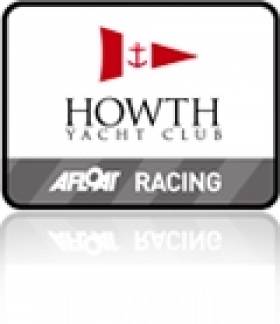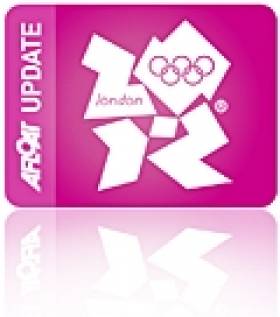Displaying items by tag: Royal North of Ireland YC
Kennedy and Kane Produce the Goods on Day Two of RS400 Winter Series at Royal North of Ireland YC
Week two of the RS400 Winter Series at Royal North of Ireland YC series on Belfast Lough arrived dank and dismal on Sunday with light rain and a forecast including 29-knot gusts; what a contrast to the previous bright and sunny weekend, which had seen the return of Bob Espey into the class, notching two bullets but with the overall lead being taken by cousins Ross and Andrew Vaughan. The forecast likely put off a few potential players as only 15 boats out of the 25 entered reached the start line.
In fact, the wind strength had dropped considerably in the hour before the scheduled start, although still from the southeast, meaning that the breeze was diminished by the Holywood hills, leaving anything from 5-18 kts with direction varying around 40 degrees in short-lived gusts tumbling down over the trees. Carrickfergus SC, on the north side of Belfast Lough, had been forced to cancel their racing, facing the full force of the southerly breeze.
Andrew Vaughan was now the helmsman in his boat – cousin Ross, unable to make it this weekend, had suggested that he headhunt a “top helm” to make sure that their good start in the series was consolidated, but Andrew answered in the best way possible, scoring another 2,3,4 for the day, the same as with Ross at the back of the boat the week before!
 15 boats out of the 25 entered for the RS400 Winter Series at Royal North of Ireland YC contested the second Sunday of racing Photo: Calum Dalzell
15 boats out of the 25 entered for the RS400 Winter Series at Royal North of Ireland YC contested the second Sunday of racing Photo: Calum Dalzell
Peter Kennedy and Stephen Kane had fared badly last week and decided the answer to an OCS and RET was to cheer themselves up with a new (one-year-old) boat!
Setting a start and first beat was a challenge for any race officer, with Gerry Reid finding a mean direction for both and settling for that; there was a big left shift 30 seconds before the first start with several boats trapped too low and unable to cross the line, leaving Jocelyn Hill and Rowan Berry to tack onto port at the pin and sail into a comfortable lead at the first mark; however they were hunted down by Tom Purdon and Olivia Hayes who found a nice shift and gust down the last run to sneak past them at the last mark and take the first gun, also his maiden win since his first appearance at the RNIYC winter event. Liam Donnelly and Rick McCaig did something they hadn’t managed for many years and rolled in for a swim, nosediving after a gybe into an unyielding wave.
There was controversy at the start of the second with race officer Reid rolling into the 3-minute start sequence – after his capsize, Donnelly was heading up the short last beat when the three sticks appeared, with half of the fleet still catching breath after the first race; again it was Hill who was most alert and took the lead after the start. Kennedy was close behind, and they swapped the lead over the next couple of legs, with Vaughan also getting past Hill on the last downwind after he took a brave foray to the left-hand corner and found a long-lasting gust to move him up to second behind Kennedy.
The last race marked the return of Donnelly – the fleet might have stopped to applaud his perfect port tack start at the pin, as he raced into a big lead up the first beat, only to ruin it by getting his legs tangled in rope on the last tack, getting stuck in irons and letting three boats past. Kennedy was there to capitalize, and he stretched into a safe lead over the next few legs; Purdon was in second to complete an excellent 1,2,6 result for the day.
Three races were completed in tough conditions for competitors and race management alike.
RS400 Winter Series - Daily Results for 12 Nov 2023
 RS400 Winter Series - Daily Results for 12 Nov 2023
RS400 Winter Series - Daily Results for 12 Nov 2023
GP14s Gather at Royal North for Autumn 'Hot Toddy' Event on Belfast Lough
The first of the annual GP14 Hot Toddy events listed in the class calendar will be held this weekend (30th September -1st October) at the Royal North of Ireland Yacht Club on Belfast Lough.
The event originates at East Antrim Boat Club on Larne Lough, but the meet is now hosted by various sailing clubs throughout Ireland.
This year, the organisers are expecting around 30 GP14s. Apart from the Royal North home fleet, visitors are expected from Sutton, Blessington, Howth, Moville, Lough Erne, and Strangford Lough, and at least one boat is making the trip from England.
This will be a highly competitive fleet, with some of the resident boats on home waters expected to do well. However, given the quality of the visitors attending, they will have a tough task.
Six races are scheduled, with three races each day, and the current weather forecast is favourable for both days. Bushmills sponsor the event.
Squibs Gather at Royal North of Ireland YC
#squib – The Royal North of Ireland Yacht Club hosts the Squib Northern Irish Championship on the weekend of the 30/31 May 2015. The Championship will see entries from all the squib fleets from around Ireland with Royal North having the largest fleet of Squibs in the north. David Eccles on Inshallah will be competing to retain his title against past winners including John Driscoll on Aficionado, Gordon Patterson on Quickstep 111 and current Irish National Squib champion Ross Vaughan on Joint Venture. Commodore Thomas Anderson said " I am delighted to see the Irish Squib Class are coming back to RNIYC for the Rodgers and Browne Northern Irish Championship and to welcoming visitors from Strangford Lough, Dublin Bay and possibly Cork"
Squib National title stays in the North
Sailing ‘Quickstep III’, the Cultra duo took the trophy ahead of clubmates David Eccles and Philip Hutchinson in ‘Inshallah’ while a strong performance from Howth’s Fergus O’Kelly and Jonathan Wormald in ‘Whipper Snapper’ was rewarded with 3rd overall.
In stark contrast to the heavy conditions of the second day, the final race was delayed for over an hour until there was sufficient wind to start. Race Officer Derek Bothwell was later obliged to shorten the race which was won by the eventual series runners-up.
Another RNIYC boat, ‘Born Wild’ (T&J Anderson) was second with O’Kelly/Wormald in third but 5th for ‘Quickstep III’ was more than enough to see Nolan and Patterson deservedly top the series.
Howth’s Jonathan Craig and Hazel Ruane in ‘Kerfuffle’ will be well satisfied with 4th overall, a point ahead of defending champions Peter Wallace and Kerry Boomer in ‘Toy for the boys’ from Cultra.
SIAC Construction Irish Squib Championships at HYC – overall results:
- Quickstep III Ross Nolan/Gordon Patterson - RNIYC 14pts
- Inshallah David Eccles/Philip Hutchinson - RNIYC 19pts
- Whipper Snapper Fergus O’Kelly/Jonathan Wormald - HYC 21pts
- Kerfuffle Jonathan Craig/Hazel Ruane - HYC 26pts
- Toy for the Boys Peter Wallace/Kerry Boomer - RNIYC 27pts
- Sensation Marcus & Meagan Hutchinson - KYC 37pts
Murphy Heading for Australian Regatta
The National Yacht Club's Annalise Murphy (Laser Radial) travelled to Australia last weekend for the Perth International Regatta http://www.perth2011.com/ which starts on the 16th of this month. The aim is to gain valuable experience at the venue which will host the December 2011 ISAF World Championships and which will be a vital qualifying event for the the 2012 London Olympic games.
Also heading for Perth is the Royal St. George's Ben Lynch in the high speed 49er dinghy.
After Perth, Annalise travels to Melbourne for the season's first ISAF World Cup event which will be run from Sandringham Yacht Club from 12-19th December. Annalise is currently ranked 20th Womens Laser Radial sailor and 1st under 21 in the World and is campaigning full time to represent Ireland in the 2012 London Olympic Games.
Top youth Laser Radial Sailor Ross Vaughan from the Royal North of Ireland YC has gone down as a training partner for Annalise together with her coach Rory Fitzpatrick.
Also taking part in the Perth Regatta are Irish 49er team of Ryan Seaton and Matt Mc Govern (Ballyholme YC) and Ross Hamilton from the RIYC, Dun Laoghaire.































































